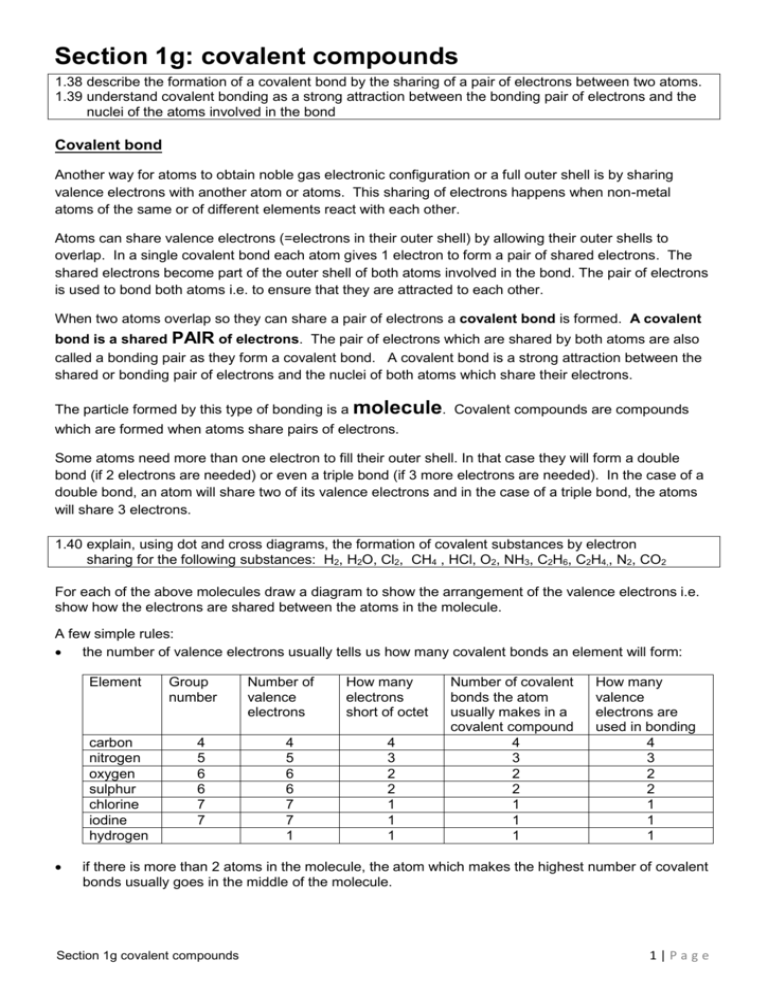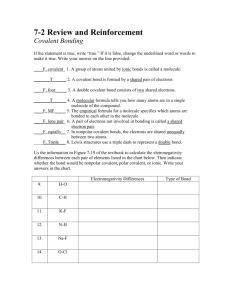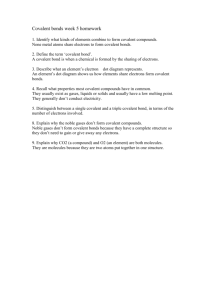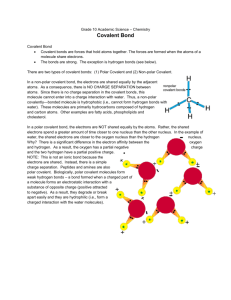Section 1g covalent compounds
advertisement

Section 1g: covalent compounds 1.38 describe the formation of a covalent bond by the sharing of a pair of electrons between two atoms. 1.39 understand covalent bonding as a strong attraction between the bonding pair of electrons and the nuclei of the atoms involved in the bond Covalent bond Another way for atoms to obtain noble gas electronic configuration or a full outer shell is by sharing valence electrons with another atom or atoms. This sharing of electrons happens when non-metal atoms of the same or of different elements react with each other. Atoms can share valence electrons (=electrons in their outer shell) by allowing their outer shells to overlap. In a single covalent bond each atom gives 1 electron to form a pair of shared electrons. The shared electrons become part of the outer shell of both atoms involved in the bond. The pair of electrons is used to bond both atoms i.e. to ensure that they are attracted to each other. When two atoms overlap so they can share a pair of electrons a covalent bond is formed. A covalent bond is a shared PAIR of electrons. The pair of electrons which are shared by both atoms are also called a bonding pair as they form a covalent bond. A covalent bond is a strong attraction between the shared or bonding pair of electrons and the nuclei of both atoms which share their electrons. The particle formed by this type of bonding is a molecule. Covalent compounds are compounds which are formed when atoms share pairs of electrons. Some atoms need more than one electron to fill their outer shell. In that case they will form a double bond (if 2 electrons are needed) or even a triple bond (if 3 more electrons are needed). In the case of a double bond, an atom will share two of its valence electrons and in the case of a triple bond, the atoms will share 3 electrons. 1.40 explain, using dot and cross diagrams, the formation of covalent substances by electron sharing for the following substances: H2, H2O, Cl2, CH4 , HCl, O2, NH3, C2H6, C2H4,, N2, CO2 For each of the above molecules draw a diagram to show the arrangement of the valence electrons i.e. show how the electrons are shared between the atoms in the molecule. A few simple rules: the number of valence electrons usually tells us how many covalent bonds an element will form: Element carbon nitrogen oxygen sulphur chlorine iodine hydrogen Group number 4 5 6 6 7 7 Number of valence electrons 4 5 6 6 7 7 1 How many electrons short of octet 4 3 2 2 1 1 1 Number of covalent bonds the atom usually makes in a covalent compound 4 3 2 2 1 1 1 How many valence electrons are used in bonding 4 3 2 2 1 1 1 if there is more than 2 atoms in the molecule, the atom which makes the highest number of covalent bonds usually goes in the middle of the molecule. Section 1g covalent compounds 1|Page There are two types of covalent substances i.e. substances with covalent bonds: covalent substances with a simple molecular structure covalent substances with giant molecular structures The structure determines the physical properties of the compound. Simple molecular structures 1.41 recall that substances with simple molecular structures are gases or liquids, or solids with low melting points 1.42 explain why substances with simple molecular structures have low melting points in terms of the relatively weak forces between the molecules Simple molecular structure refers to a structure in which small molecules are attracted to each other by weak intermolecular forces. Within the molecules the atoms are held together by covalent bonds which are strong. Examples of substances with simple molecular structures are all the substances for which you drew cross and dot diagrams on page 1. Others substances are iodine, carbon monoxide, glucose, ethanol,…. The physical properties of simple molecular substances depend on the intermolecular forces which are weak. As a result molecules motion. need little energy to overcome them and increase their Simple molecular substances have the following properties: low melting and boiling points which is why many molecular compounds are gases or liquids those which are solids are volatile i.e. they change state easily because they have low melting and boiling points; simple molecular solids are brittle. they do not conduct electricity at all most are insoluble or have low solubility in water such as methane whilst other molecular substances, such as ammonia and hydrogen chloride, are soluble. Giant covalent structures 1.43 explain the high melting points of substances with giant covalent structures in terms of the breaking of many strong covalent bonds 1.44 draw diagrams representing the positions of the atoms in diamond and graphite 1.45 explain how the uses of diamond and graphite depend on their structures, limited to graphite as a lubricant and diamond in cutting A giant covalent structure refers to a structure in which a very large number of atoms are held together by a very large number of strong covalent bonds that extend in all directions. There are no weak intermolecular forces in this structure. The melting and boiling of such substances requires a lot of energy for the atoms to break the covalent bonds which are strong and of which there are many. As a result giant covalent structures have very high melting and boiling points. Section 1g covalent compounds 2|Page Examples of giant covalent structures Both diamond and graphite are two of the different forms – allotropes - in which carbon can exist in nature. Allotropes are different forms of the same element. Both the structure of diamond and graphite has the following characteristics: the lattice has carbon atoms only – there are no molecules in it; the atoms are held together by strong covalent bonds the lattice has millions of carbon atoms going in all directions. Both diamond and graphite have a giant covalent structure = a structure in which a very large number of separate atoms are held together by strong covalent bonds only. Giant structure means that the bonding goes on and on to the edge of the crystal. It is different from a simple molecular structure, in which, although the bonds between the atoms in a molecule are strong covalent bonds, the intermolecular forces of attraction are weak. The strong covalent bonds explain the hardness and high melting and boiling points of giant covalent substances! How are diamond and graphite different? Both are giant covalent solids but differ in some properties because of an important structural difference. diamond graphite The carbon atoms in diamond form a threedimensional structure: each carbon atom in the diamond lattice has made strong covalent bonds with 4 other carbon atoms In the graphite lattice each carbon has made covalent bonds with only 3 atoms which are all in the same layer. Graphite has a layer structure with the carbon atoms in the same layer bonded to each other by strong covalent bonds. The layers themselves are held together by weak intermolecular forces. Because of these differences in structure, graphite and diamond have the following different properties and uses: Difference Diamonds are hard which is why Reason Diamond is used for cutting because all atoms are held together by strong covalent forces (there is no other force in the lattice); covalent bonds between all atoms Graphite is used as a lubricant because it is soft and slippery because the carbon atoms in graphite are in layers which easily slip past each other as they are held in place by weak intermolecular forces. diamonds are used for cutting Graphite is soft which is why it used as a lubricant (=substance used to reduce friction). Section 1g covalent compounds 3|Page Diamond is an insulator whilst there are no mobile charged particles Graphite conducts each carbon atoms has only made 3 covalent bonds and has therefore only used 3 of its 4 valence electrons; the valence electrons that has not been used to make covalent bonds can move freely throughout the lattice (delocalised electron) There is a third allotrope of carbon which is called a buckminsterfullerene. It consists of molecules (C60) made up of 60 atoms bonded covalently and arranged in the form of a football. Between the molecules there are weak intermolecular forces. Because of these weak intermolecular forces fullerenes sublime easily. Other examples of giant covalent structures are silicon and silicon dioxide. silicon Section 1g covalent compounds silicon dioxide 4|Page








